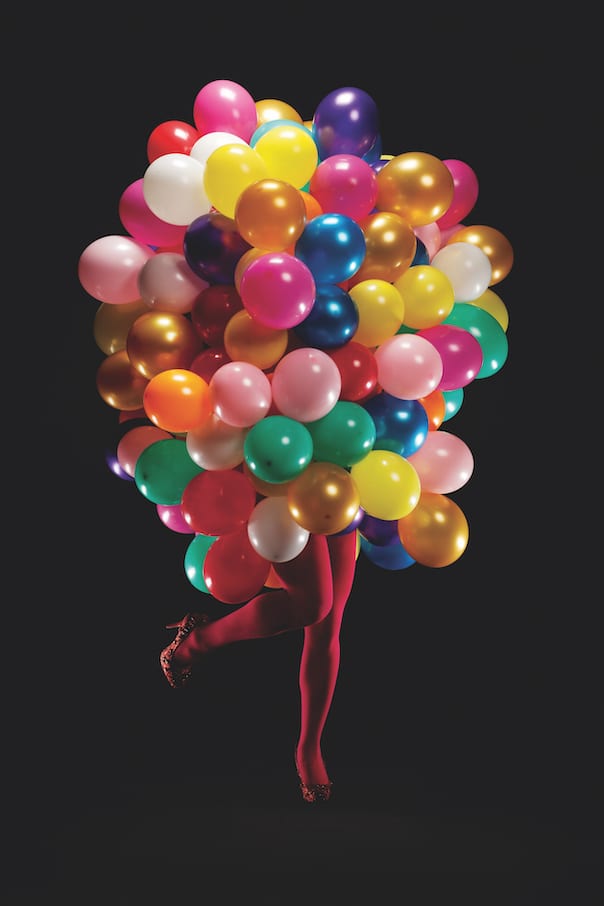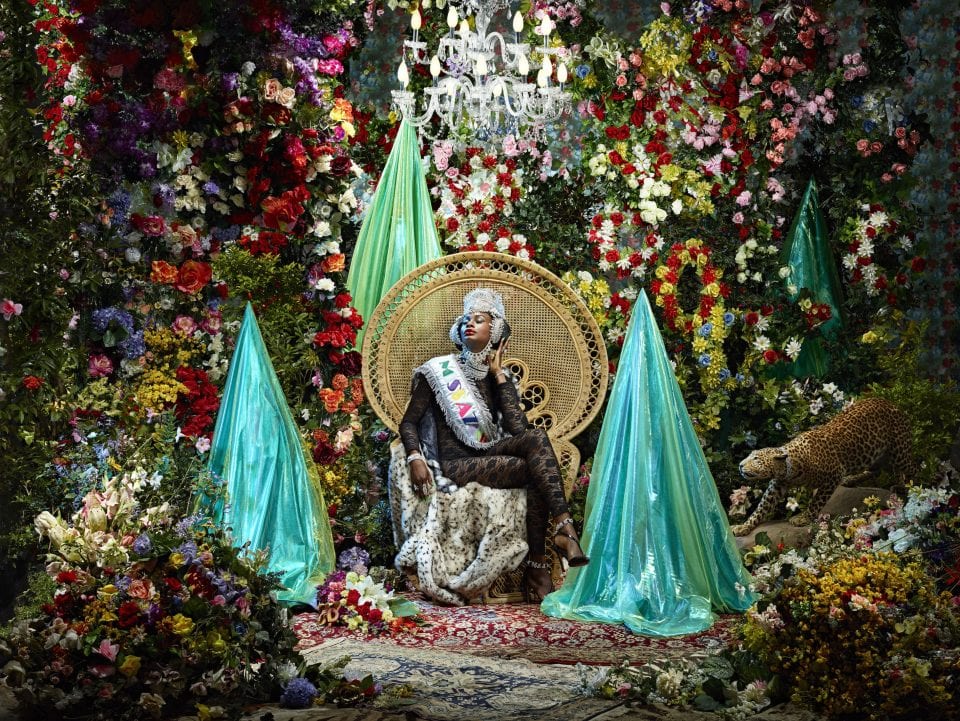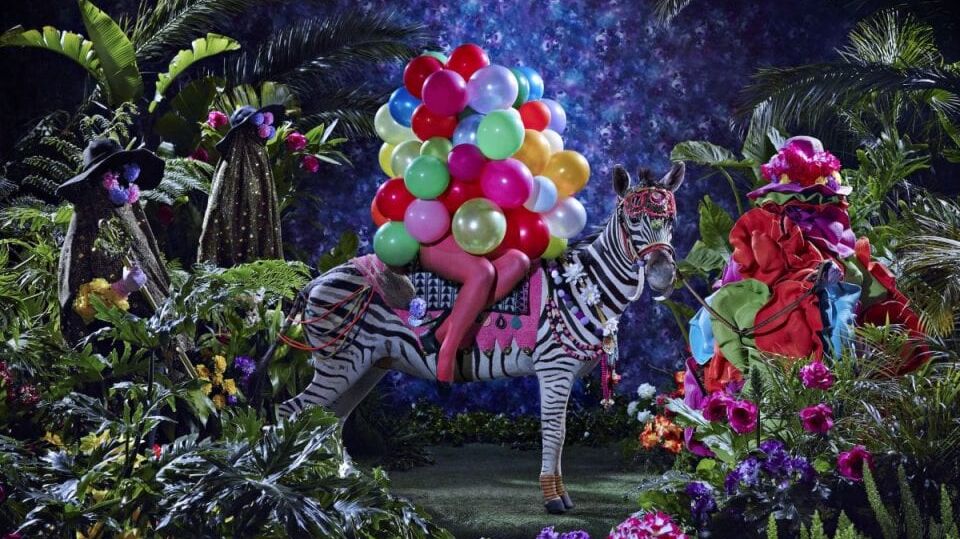Through bold costume, colours, pageantry and performance, Ruga’s
works ask meaningful questions about how to decolonise the art sector.
Athi-Patra Ruga (b. 1984) is a South African visual artist who addresses the history of colonialism to offer a new, humanist vision for the future. Through bold and colourful compositions, each of Ruga’s fantastical images explore sexuality, queer identities, cultural hybridity and post-colonial landscapes. Performance, photography, video, textiles and printmaking come together to present characters, or “avatars” that parody existing socio-political constructs. Ruga has exhibited at Sean Kelly Gallery, Seattle; Louis Vuitton Fondation, Paris; YBCA, San Francisco; Tate Modern, London; Guggenheim Museum, Bilbao; Somerset House, London; and most recently with Hayward Gallery for the Kiss My Genders exhibition (12 June – 8 September 2019). His work also appears in both private and public collections such as the Smithsonian Museum of African Art, Washington D.C
A: Your images are Fantasia-like, tapping into ritual and procession. How do they create their own mythology?
A-PR: It is through the act of looking. When I compose an image, I make a point to draw attention to certain elements that create a clash between reality and fantasy. The resulting works are a nod to the vernacular and the Occidental: staid ways of looking at and making things “beautiful.” I consider a range of ways in which western societies survey art through accepted means of communication, such as academia.
A: How do your images undermine utopias, building progressive worlds that question power structures?
A-PR: Globally, we are living through a resurgence of nationalism and rising group mentalities. Unfortunately, we live in a sad state of consciousness, grounded on the principles of “us” and “them.” In spite of this, there’s an even stronger fightback from artists, humanists and lovers of individuality, who are combatting this false sense of evolution. In an “Imaginarium” of sorts, I present the fictional state of Azania – a name that is heavily associated with the hopes and dreams of struggles from pre-1994 black South Africans. It is a word that offered hope for the future – a geographic location that has been written about since 40 AD. I would even call my photographs a utopian exercise – redressing South Africa’s sense of loss from having its cultural identity interrupted by inhuman exercises like colonialism and segregation. Like Zion or Trump’s “Great America,” we tend to hark back to a golden age and layer it with imagery – as well as dangerous courses of action – to achieve the desired state of “societal purity.” What is this idea of America that needs to be great again? Utopias are a concept that need to be defended by their creators – utilising the polarised notions of “us” and “them” in order to maintain power and influence over people. Armies and border control are called in to reinforce these ideas. This rhetoric plays out in The Future White Women of Azania series (2010-2017), which displays an intersectional struggle. I had to carve and fight for a kind of safe space. The result is Azania.

A: Your images are Fantasia-like, tapping into ritual and procession. How do they create their own mythology?
A-PR: It is through the act of looking. When I compose an image, I make a point to draw attention to certain elements that create a clash between reality and fantasy. The resulting works are a nod to the vernacular and the Occidental: staid ways of looking at and making things “beautiful.” I consider a range of ways in which western societies survey art through accepted means of communication, such as academia.
A: How do your images undermine utopias, building progressive worlds that question power structures?
A-PR: Globally, we are living through a resurgence of nationalism and rising group mentalities. Unfortunately, we live in a sad state of consciousness, grounded on the principles of “us” and “them.” In spite of this, there’s an even stronger fightback from artists, humanists and lovers of individuality, who are combatting this false sense of evolution. In an “Imaginarium” of sorts, I present the fictional state of Azania – a name that is heavily associated with the hopes and dreams of struggles from pre-1994 black South Africans. It is a word that offered hope for the future – a geographic location that has been written about since 40 AD. I would even call my photographs a utopian exercise – redressing South Africa’s sense of loss from having its cultural identity interrupted by inhuman exercises like colonialism and segregation. Like Zion or Trump’s “Great America,” we tend to hark back to a golden age and layer it with imagery – as well as dangerous courses of action – to achieve the desired state of “societal purity.” What is this idea of America that needs to be great again? Utopias are a concept that need to be defended by their creators – utilising the polarised notions of “us” and “them” in order to maintain power and influence over people. Armies and border control are called in to reinforce these ideas. This rhetoric plays out in The Future White Women of Azania series (2010-2017), which displays an intersectional struggle. I had to carve and fight for a kind of safe space. The result is Azania.
A: Your background is in fashion; how has this informed the styling and use of material in the images?
A-PR: First of all, I attended Belgravia Art College in East London to study painting and art history. This, coupled with further studies in Fashion History, gave me a range of disciplines to work with. I now approach textiles – and conversations around clothing – as a means of communication. In South Africa, there are many cultural groups who have elevated costume to be a kind of non-verbal form of communication. This is evident, and perhaps blown out of proportion, in my photographic works. Azania, and all of its avatars’ fates, exist in the realm of costume and decoration; I present large-scale tapestries that reference medieval wall hangings in which function meets with storytelling.

A: Why do many of the figures remain faceless?
A-PR: I have learnt that removing faces is a way of allowing the audience to project themselves, or rather their identities, onto any of the given avatars. I use a range of materials to achieve this, from hair to balloons. Historically, my queer, black and femme identity has been veiled by society’s lack – or inadequacy – of acceptance. Like many others, I have been rendered as an alien: omitted. From the perspective of performance, the characters are reflective of “alien” beings. The choreography, as well as the stilettos and the hidden face, tells the story of navigating the world with difficulty.
A: Each piece is meticulous, with bold sets, props and styling. How do you plan projects from start to finish?
A-PR: My series are a result of very focused craftsmanship – which is the cornerstone of my studio. The sets are designed and stitched together in Cape Town. Each of the elements is delivered separately and then we install the sets within a day. I collaborate with those working in film design, allowing for a larger sense of scale that envelops the audience.
A: How do each of the objects help to build up a wider sense of storytelling? What is their relevance, as singular subjects, and as part of a larger collective?
A-PR: These images are about procession and pageantry; this comes through in the choreography of heroic poses and sacred compositions. Then there’s also a nod to the traditions of African studio photography. We ramp up the decoration and start introducing objects that initiate a sense of conflict and visual tension. Nature becomes staged. Fauna is tamed. These are primitive arrangements of “the negro” posing with “the animal” as a way to explore the idea of “feral” characters. I play with the idea of primitivism and levels of “civilisation.”

A: You have described your works as “colourful yet frightening” – containing many textures and layers. How do your images convey meaning through detail?
A-PR: The stories I tell are through colour; it allows me to deal with the heaviest of topics, such as death or civil clashes, from the outside world. Colour has the ability to not only pacify the audience, but it allows me to enter into new places. As I’m typing this, I am in isolation. I find that the presence of colour can also highlight where it is lacking – where it is missing. We regard colour only when it enters our eyes and it usually elevates our mood. However, it can also highlight the reality that the world isn’t all that colourful in actuality.
A: Many of your works have violent titles. How do you choose these and what do they signify?
A-PR: With all the “festivities” that are unfolding in the work, I often think back to the main reason I started to create. I wanted to explore how nationalism is bolstered by pageantry, for example, by the idea of the Beauty Queen – a notion that plays on the femme body. Figures that walk down ramps, in order to represent a nation, are probably part of a patriarchal construct. Night of the Long Knives signifies a bloody historic event. It qualifies an image that might otherwise be described as “festive.” The title drags us back to reality; it allows viewers to toy with utopias and consider how society might be lacking. Imagine watching an episode of The Real Housewives of Atlanta and then immediately switching channels to a report on gender-based violence.
A: What projects have you produced since lockdown?
Are you building on any previous ideas?
A-PR: I am presenting a saga in two parts at the WHATIFTHEWORLD Gallery in Cape Town (and online) titled Interior Exterior / Dramatis Personae. This trans-media piece includes a series of stained glass windows that deify unexpected characters: those who wouldn’t usually be presented in the grand moral tales of traditional stained glass. This includes avatars that I have been performing as over the last 15 years. In this work, they are being deified for who they are in an Azanian set of moral tales (contradictory utopian nationalistic ideals). My stained glass subjects range from muscle leather-men – inspired by Irma Stern – to François “Féral” Benga: a Senegalese dancer from the early 1900s. He used to do drag performances of his colleagues. The second part of the piece, Dramatis Personae, is introducing my new avatar: Nomalizo Khwezi. The figure is presented in tapestry-form, peeking into her psychology, which is made up of tropes from Xhosa literature, specifically those that are published in the 200-year-old Lovedale Press, stretching back to the turn of the 20th century. Titles like Ingqumbo yemiNyanya (The Wrath of the Ancestors) and Ithemba liyaphilisa (Hope Heals) are upended as they have had a strong hold on respectability politics in my Xhosa society. This work forms part of a larger trans-media series entitled The Lunar Songbook. Last year, I was accepted into the Locarno Film Academy and attended masterclasses led by John Waters and Bong Joon-ho. This is part of a feature film in development, which I started there.

A: What do you hope viewers take from your images? Is there something you aim towards in each project?
A-PR: I hope that audiences have experienced the highest levels of technique and storytelling. This is coupled with the desire that I have allowed them the courage to face scars and wounds using the platform of an objective place. The end goal, for me, is that I dignify the imaginations and identities of communities which are black, femme, queer and alive.
A: What role should artists play in 2020? What has been your takeaway from the global lockdown?
A-PR: Never has there been a more important time for a new generation of artists. Lockdown has proven that the arts are not some rarefied activity for collectors. The arts aren’t esoteric. Film is a magic collaboration. Music carries our souls along. We call for these media to celebrate the health workers who are taking care of lives. So, let this be a time to reflect on the fact that we have entered a new era that will demand that you know your purpose as an artist. Document this time as much as possible, so when we reflect on this crisis, we will think of new opportunities. Strive to be in service.
Kate Simpson
whatiftheworld.com
instagram.com/athipatra
Lead Image: Detail, Athi-Patra Ruga, Night of the Long Knives I, 2013. Archival Ink-jet Print on Photorag Baryta. 150 x 190 cm. Edition of 5 + 2 AP. Photographer: Hayden Phipps. © Athi-Patra Ruga. Courtesy of Athi-Patra Ruga and WHATIFTHEWORLD.
1. Detail,Athi-Patra Ruga, Night of the Long Knives II, 2013. Archival Ink-jet Print on Photorag Baryta. 150 x 190 cm. Edition of 5 + 2 AP. Photographer: Hayden Phipps. © Athi-Patra Ruga. Courtesy of Athi-Patra Ruga and WHATIFTHEWORLD
2. Athi-Patra Ruga …A Vigil for Mayibuye, 2015. Archival ink-jet print on Photorag Baryta. 150 x 190 cm.
Edition of 10 + 2 AP. Photographer: Hayden Phipps. © Athi-Patra Ruga. Courtesy of Athi-Patra Ruga and WHATIFTHEWORLD.
3. Athi-Patra Ruga, The Future White Woman of Azania 1, 2012. Inkjet
print on Hahnemühle photo rag. 80 x 120 cm. Edition of 5 + 3 AP. Photographer: Hayden Phipps.
© Athi-Patra Ruga. Courtesy of Athi-Patra Ruga and WHATIFTHEWORLD.
4. Athi-Patra Ruga, Umesiyakazi in Waiting (From the Exile series, previously Miss Azania 2015), 2019. Archival Ink-jet Print on Photorag Baryta.
161 x 205 cm. Edition of 10 +2 AP. Photographer: Hayden Phipps. © Athi-Patra Ruga. Courtesy of Athi-Patra Ruga and WHATIFTHEWORLD.





